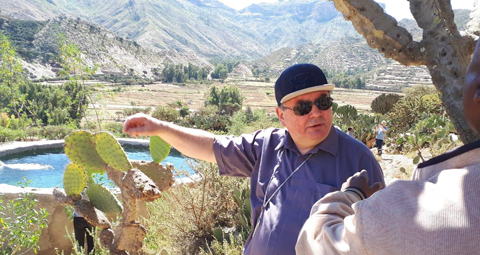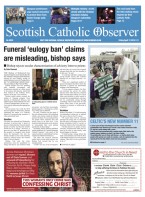February 1 | ![]() 0 COMMENTS
0 COMMENTS ![]() print
print

Oasis of hope in Northern Ethiopia: Bishop Toal on the Faith of the African country and the helping hand offered by SCIAF
In the wake of a visit to a country once stricken by famine, Bishop Joseph Toal explains how Scots have helped Ethiopians thrive.
AFTER returning from a week spent visiting SCIAF-supported projects in northern Ethiopia, I have some thoughts to share on what was a fascinating experience.
I have seen first hand something about this large and complex north-east African country and the outstanding work undertaken by SCIAF and our partners throughout the local Diocese of Adigrat, supporting rural communities as they seek to improve people’s lives in what is a challenging natural environment.
Many of us remember Ethiopia from the terrible famine experienced there in the 1980s and how Bob Geldof and Band Aid encouraged us to respond generously to people in such extreme need.
When told that our trip would be to Northern Ethiopia and would take in Tigray province, I remembered that this was the region affected by the drought and famine over 30 years ago and was aware before travelling that life remains precarious today as water remains scarce and annual rainfall is even more unpredictable today as a consequence of climate change.
It is true though that Ethiopia has developed in many ways since then and its people, like all of us, aspire to continue this progress by all means available.
The landscape of Northern Ethiopia is spectacular, especially when you travel into the mountains but it looks and feels extremely dry and can be very, very hot.
To find sufficient sources of water, and to share the water that does fall during the rainy season, has always been part of the challenge of living in such areas.
Traditionally many of rural population are pastoralists, which means they keep goats and sheep and move around seeking pasture for them, hoping to sustain themselves through their animals.
Those living closer to reliable water sources are able to grow crops and keep larger animals, particularly oxen which assist with ploughing and other heavy farming tasks.
Donkeys also greatly assist the transport of goods through areas where roads are very rough and transport by motor vehicles restricted.
The group from SCIAF visited a number of communities which have been helped to access, store and circulate the collected water and slow its flow when the rain does fall in torrents.
SCIAF supports work undertaken by local people, including digging boreholes to access water deeper underground and providing solar panels to power pumps to lift the water to ground level for distribution.
SCIAF also provides cement for building irrigation canals, bringing new areas of land under cultivation.
With a regular supply of water, the fields now produce three harvests a year, rather than the single one that followed the rainy season.
Water collection points for humans and animals are now situated at different points within the communities and more water is available for human consumption, cooking and washing.
It was tremendous to see what has been achieved and to appreciate how much of a difference our contributions make to the long-term transformation of people’s lives in these sometimes isolated communities.
The provision of solar panels to power water pumps has guaranteed a regular water supply for a community twice the size of Motherwell’s.
It is a great blessing for the community, which is mainly Muslim, and they deeply appreciate the support of Adigrat Diocese and her partners, including SCIAF.
Another feature of the water projects is the construction of check-dams at strategic points on a river which allows water to be pumped into the surrounding fields. When the heavy rainfalls come, the dams slow the speed of water and give time for it to seep into the ground thus replenishing deeper water reserves.
Another feature of this work is the construction of dams at higher levels to slow the flow of water on the hillsides so preventing the soil being washed away. This is very important where too many trees have been cut down for firewood and other uses.
Once again great work is being done by the local people and their growing awareness of how they can better their traditional way of farming with the help of modern technology which we have helped provide.
Our hosts in Tigray were Bishop Tesfaselassie of Adigrat and his Social and Development Commission.
They gave us a great welcome and emphasised the great bond between us in the Universal Church and how the sharing of our resources is a powerful sign of our union in Christ.
For me this is a strong part of SCIAF’s mission—through our aid agency the Catholics of Scotland reach out to the Church in poorer countries and share what we can with them.
It is uplifting to see this working and, as a Scottish bishop, to hear the gratitude expressed by the local bishop for the generosity of Scottish Catholics.
So I bring back a very positive message to Scotland about SCIAF’s work in Ethiopia and in other countries from the people of the Church—they love us very much and greatly appreciate our help.
In visiting the Church in other places I also expect to learn something about Christian Faith and living.
The Church in Ethiopia is very ancient, going back to the 4th century, and is predominantly Orthodox. Since coming to Ethiopia through the 19th century missionaries, the Catholic Church, although small, has been active in health, education, and social provision, but remains close to the orthodox tradition in many ways.
One part of Christian life which has prominence is fasting. Wednesday and Friday each week are days of fasting, along with Lent and some other extended periods through the year.
On these days people abstain from meat, fish, and all food produced from animals—basically, they follow a vegan diet. We are not used to fasting to this extent in the Western Church but we are challenged about it sometimes, not least by Pope Francis.
Certainly during Lent we do take seriously the disciplines of prayer, fasting, and almsgiving, and having visited the Church in Ethiopia, I will be thinking about what I should do in that regard. Since Lent is also the time we make a special effort for SCIAF I will certainly encourage a generous response from Scotland’s Catholics having seen that we support such beneficial work in Ethiopia.
We are not the only ones who do so but the fact that we do so in the name of the Catholic Church in Scotland makes what we do very special in our Church’s life and mission.










